What Does It Mean When a Drug is Described as Easy to Administer
How to Use Liquid Medicines for Children
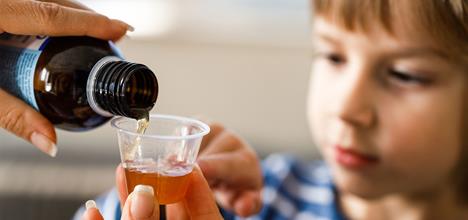

Page Content
Many children's medicines come in liquid form. Liquid medicines are easier for children to swallow than pills. However, make sure to use them the right way so your child gets the amount they need.
Here's what parents need to know.
Types of liquid medicines
There are 2 types of liquid medicines:
-
Medicines you can buy without a doctor's prescription (called over-the-counter or OTC).
-
Medicines a doctor prescribes.
OTC medicines
-
All OTC medicines have the same kind of label. The label gives important information about the medicine. It says what it is for, how to use it, what is in it, and what to watch out for. Look on the box or bottle, where it says "Drug Facts."
-
Check the chart on the label to see how much medicine to give. If you know your child's weight, use that first. Be careful. Your child's weight in kilograms is different from your child's weight in pounds (lbs)! See the table below for examples of how kilograms and pounds differ from each other.)
| Kilogram (kg) | Pounds (lbs) |
| 1 | 2.2 |
| 5 | 11 |
| 10 | 22 |
| 15 | 33 |
| 20 | 44 |
- If you do not know your child's weight, go by age.
- Check the label to make sure it is safe for infants and children younger than 6 years. Pay careful attention when the label says, "Do Not Use." If you are not sure, ask your child's doctor.
- It is important to use a dosing tool that has markings on it. The markings help you measure out the right amount of medicine. Dosing tools include oral syringes, dosing spoons, droppers, and dosing cups. Always keep the dosing tool with the bottle of medicine. If a dosing tool is not included with your medicine bottle, ask your pharmacist or doctor for one.
Prescription liquid medicines
-
Your child's doctor may prescribe a liquid medicine. These medicines will have a different label than OTC medicines. Always read the label before you give the medicine to your child.
-
Like with OTC medicines, it is important to always use the dosing tool (like an oral syringe) that comes with the medicine, or that your doctor or pharmacist tells you to use. If a dosing tool is not provided with the medicine, ask the pharmacist or doctor to give you one.
-
With OTC or prescription medicines, be sure to call your child's doctor or pharmacist if you have questions like:
-
How much medicine should I give?
-
How often should I give the medicine?
-
How long should I give the medicine for?
-
Where should I keep the medicine?
-
How should I get rid of leftover medicine?
Different strengths of infant & children's medicines
Some medicines may come in different infant and children's strengths (concentrations). Be careful! The infant medicine may be stronger than the children's medicine. Parents may make the mistake of giving higher doses of infant medicine to a child, thinking that it is not as strong. Be sure the medicine you give your child is right for his or her weight and age.
How to give liquid medicines
Follow the directions exactly. Some parents give their children too much medicine. This will not help them get better faster. And it can be very dangerous, especially if you give too much for a few days in a row. Always read the label carefully.
How to measure liquid medicines
-
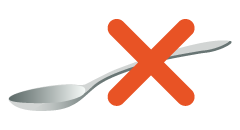 Use the dropper, syringe, medicine cup, or dosing spoon that comes with the medicine. If the medicine does not come with a dosing tool, ask your pharmacist or doctor to give you one to use. Never use teaspoons, tablespoons, or other household spoons to measure medicine.
Use the dropper, syringe, medicine cup, or dosing spoon that comes with the medicine. If the medicine does not come with a dosing tool, ask your pharmacist or doctor to give you one to use. Never use teaspoons, tablespoons, or other household spoons to measure medicine. -
Be sure to use a dosing tool that is just right to fit the dose you want to measure. The tool should not be too big, or too small. Using a dosing tool that is too big makes it easy to give too much medicine. Using a dosing tool that is too small means having to measure more than one time to give the right amount. This makes it easier to give the wrong amount.
-
Medicine can be measured in different ways. You may see teaspoon (tsp), tablespoon (tbsp or TBSP), or milliliters (mL, ml, or mLs) on the dosing tool. It is easier to measure the right amount with a dosing tool that uses milliliters (mL).
-
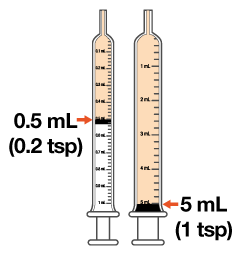 Look very carefully at how the dose amount is written. Be especially careful if you see a period (".") in the middle of the number. For example, "0.5 mL" is not the same as "5 mL". Mixing these up can mean giving 10 times more medicine than your child needs. Or it may mean giving your child 10 times less medicine.
Look very carefully at how the dose amount is written. Be especially careful if you see a period (".") in the middle of the number. For example, "0.5 mL" is not the same as "5 mL". Mixing these up can mean giving 10 times more medicine than your child needs. Or it may mean giving your child 10 times less medicine. -
If you are not sure how much medicine to give your child, talk to your doctor or a pharmacist.
-
Ask your doctor or pharmacist to show you how much medicine to give using the tool you plan to use at home.
-
Tell your doctor or pharmacist how much you plan to give, or use your tool to point to how much you plan to give. Then ask if what you said is correct.
-
Ask your doctor or pharmacist to write down the instructions on a piece of paper for you to take home.
-
Be sure to ask the doctor or pharmacist to give you information in the language you prefer. Having an interpreter help give you instructions, and having information written down in the language you prefer, means that you will be less likely to make an error.
-
Ask questions. Many parents have trouble understanding medicine instructions. If you are confused about how to give your child a medicine, it is better to ask questions than to give the medicine incorrectly.
- Keep your dosing tool with your medicine so that it is easy to remember to use them together. Keep them up and away, and out of sight of young children. That way they won't get into them when you are not watching.
Different ways of measuring medicine and what they mean
There are many ways to measure medicine - it is best to measure using milliliters instead of using teaspoons or tablespoons. Use a dosing tool that has markings with milliliters on it.
-
5 milliliters (mL) = 1 teaspoon (tsp)
-
15 milliliters = 3 teaspoons (tsp) = 1 tablespoon (Tbsp)
Remember: never use a kitchen spoon to measure out medicine. This is because kitchen spoons come in lots of different sizes. If you see instructions in teaspoons (tsp) or tablespoons (Tbsp), and you are confused, talk to your doctor or pharmacist.
Medicine cups
-
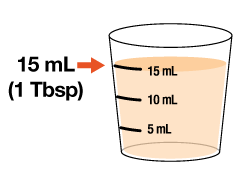 Be sure to use the cup that comes with the medicine. These often come over the lids of liquid cold and flu medicines. Don't mix and match cups to different medicines. You might end up giving the wrong amount.
Be sure to use the cup that comes with the medicine. These often come over the lids of liquid cold and flu medicines. Don't mix and match cups to different medicines. You might end up giving the wrong amount. -
Don't just fill it up. Look carefully at the lines and letters on the cup. Use the numbers to fill the cup to the right line. Ask your pharmacist or doctor to mark the right line for your child if you are not sure. Put the cup on a flat surface, like a table, to check if you have it filled to the right amount. Holding a cup tipped, or at an angle, can make you measure the wrong amount.
Dosing spoons
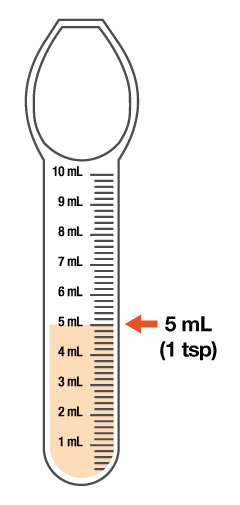 These work well for older children who can "drink" from the spoon. Use only the spoon that comes with the medicine. Be sure to use the lines and numbers to get the right amount for your child. Ask your pharmacist or doctor to mark the right line if you are not sure how much to give.
These work well for older children who can "drink" from the spoon. Use only the spoon that comes with the medicine. Be sure to use the lines and numbers to get the right amount for your child. Ask your pharmacist or doctor to mark the right line if you are not sure how much to give.
Droppers or syringes
-
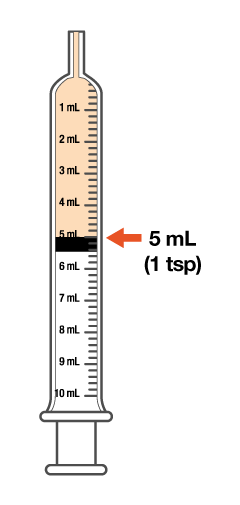
Don't just fill the dropper or syringe to the top. Read the directions carefully to see how much to give your child. Look at the numbers on the side of the dropper or syringe. Use the numbers to fill it to the right line. Or ask your pharmacist or doctor to mark the right line if you are not sure. (If the syringe has a cap, throw it away before you use it. The cap could choke your child.)
-
Don't put the medicine in the back of the throat. Instead, squirt it gently between your child's tongue and the side of the mouth. This makes it easier to swallow.
-
If it is important to measure the exact right amount, an oral syringe is usually the best dosing tool to use. This is especially true when you are measuring an amount that is less than 5 mL. If your medicine does not come with an oral syringe, talk to your pharmacist or doctor to see if you should use one, and if they can give you one.
More information
-
Medication Safety Tips
-
Using Over-the-Counter Medicines With Your Child
-
Acetaminophen Dosing Tables for Fever and Pain in Children
-
Ibuprofen Dosing Table for Fever and Pain
-
Diphenhydramine Dosing Table
-
Fever and Pain Medicine: How Much To Give Your Child
-
The Healthy Children Show: Giving Liquid Medicine Safely (Video)
Article Body
- Last Updated
- 10/11/2021
- Source
- American Academy of Pediatrics Council on Quality Improvement and Patient Safety (Copyright © 2021)
The information contained on this Web site should not be used as a substitute for the medical care and advice of your pediatrician. There may be variations in treatment that your pediatrician may recommend based on individual facts and circumstances.
Source: https://www.healthychildren.org/English/safety-prevention/at-home/medication-safety/Pages/Using-Liquid-Medicines.aspx
0 Response to "What Does It Mean When a Drug is Described as Easy to Administer"
Enregistrer un commentaire